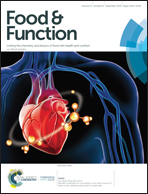Exploring variability in detection thresholds of microparticles through participant characteristics
Abstract
This study explored how product familiarity and physiological characteristics of participants affect detectability of microparticles in viscous and semi-solid foods. Cellulose particles differing in size (50–780 μm) were added (1.5% w/w) to two dairy products, quark (viscous curd cheese) and processed cheese. Discrimination thresholds for added microparticles were determined by 47 Dutch, Caucasian and 45 Chinese, Asian women using the Method of Constant Stimuli. Particle size detection thresholds did not significantly differ between the two groups, but differed significantly between the two products. Detection threshold estimates for particle size were lower in viscous, low-fat quark than in semi-solid, high-fat processed cheese (52 μm versus 86 μm). This suggests that particle detection depends on product properties such as product consistency and composition, but not on factors linked to ethnicity and/or nationality of participants. We found no evidence to support a relationship between product familiarity and particle size detection thresholds in either product. A positive but weak correlation was found between stimulated saliva flow and particle size detection threshold in processed cheese (r = 0.21, p = 0.041), suggesting active salivation might enhance sensitivity for microparticle detection in semi-solid foods. PROP status and fungiform papillae density did not correlate with particle size detection threshold for either food. We conclude that matrix properties were the main contributors to particle size detection thresholds in young, healthy participants who differed in nationality and ethnicity. These data suggest that product characteristics are the central factor that should be considered for modifications when dealing with foods in which particles lead to negative sensations such as grittiness.



 Please wait while we load your content...
Please wait while we load your content...